This vegan biscoff cake has a rich brown sugar and cinnamon spiced flavour thanks to the addition of Lotus biscoff spread. It’s filled and topped with a vegan biscoff buttercream and topped with a drizzle of more biscoff spread. Cookie butter lovers won’t be able to get enough of this vegan and dairy free layer cake!
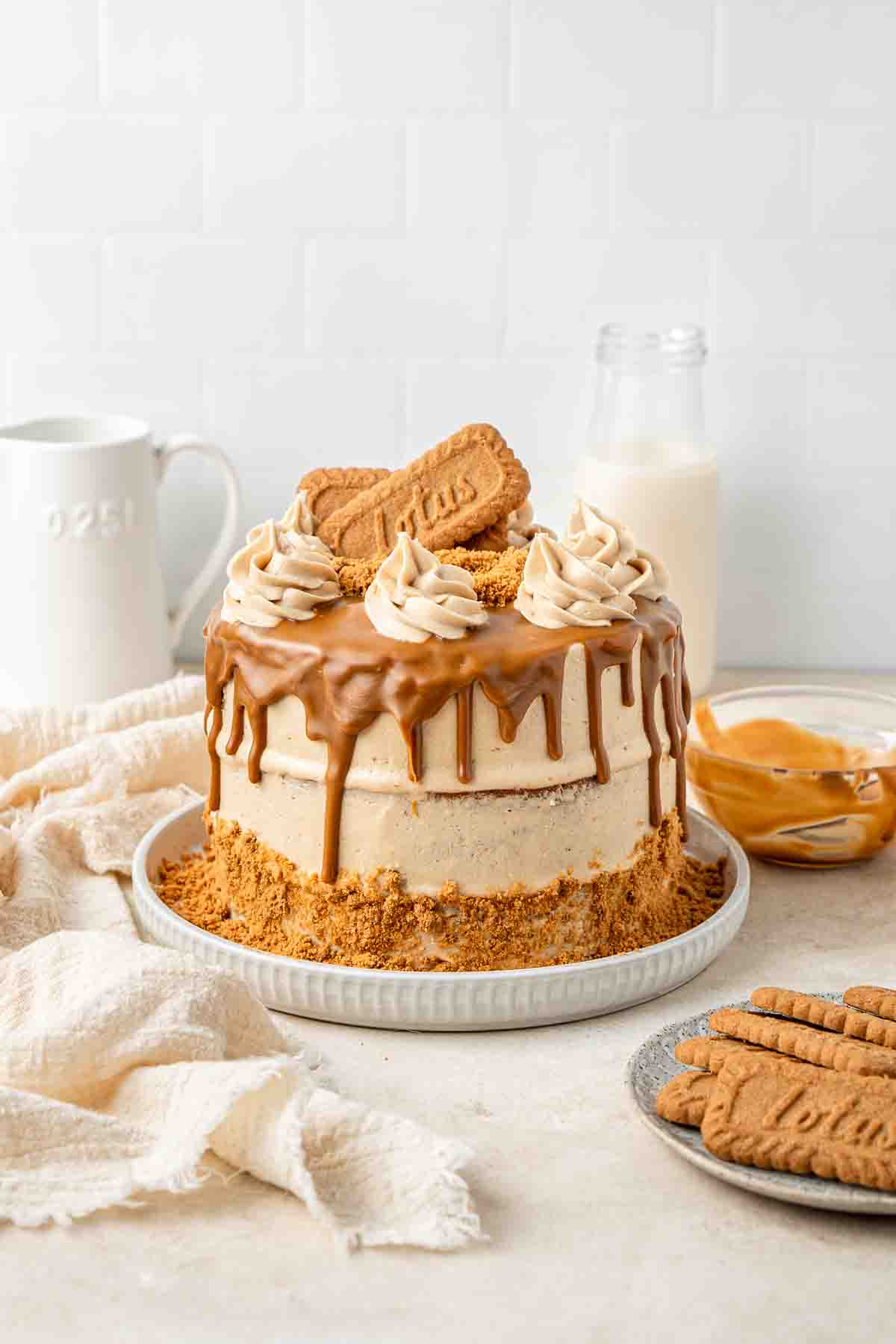
I love anything biscoff flavoured. I’ve had a couple of biscoff birthday cakes over the more recent years (including a 2 tier cake I made for my own 30th!). But the biggest oversight of my website is that I’ve never actually published my biscoff cake recipe. That changes today!
This layer cake is made dairy-free and egg-free making it perfect for vegan diets or for anyone like me with allergies that still want an incredible birthday cake that doesn’t taste like a cake that doesn’t contain eggs or dairy.
Seriously this cake is so soft and moist while being dense enough to hold up to being layered. It’s also super rich and flavourful, bringing all the flavours of the speculoos cookie into the cake thanks to the addition of cookie butter in both the cake itself and the buttercream frosting.
The cake is intentionally not too sweet on its own with the sweetness from the American buttercream balancing out the flavours. And of course I couldn’t help but finish off this cake with a biscoff drip!
Key Ingredients
To make this vegan biscoff cake, you’ll need a few of the usual pantry staple ingredients so as long as you’ve picked up a jar of biscoff spread, you don’t need any other special ingredients.
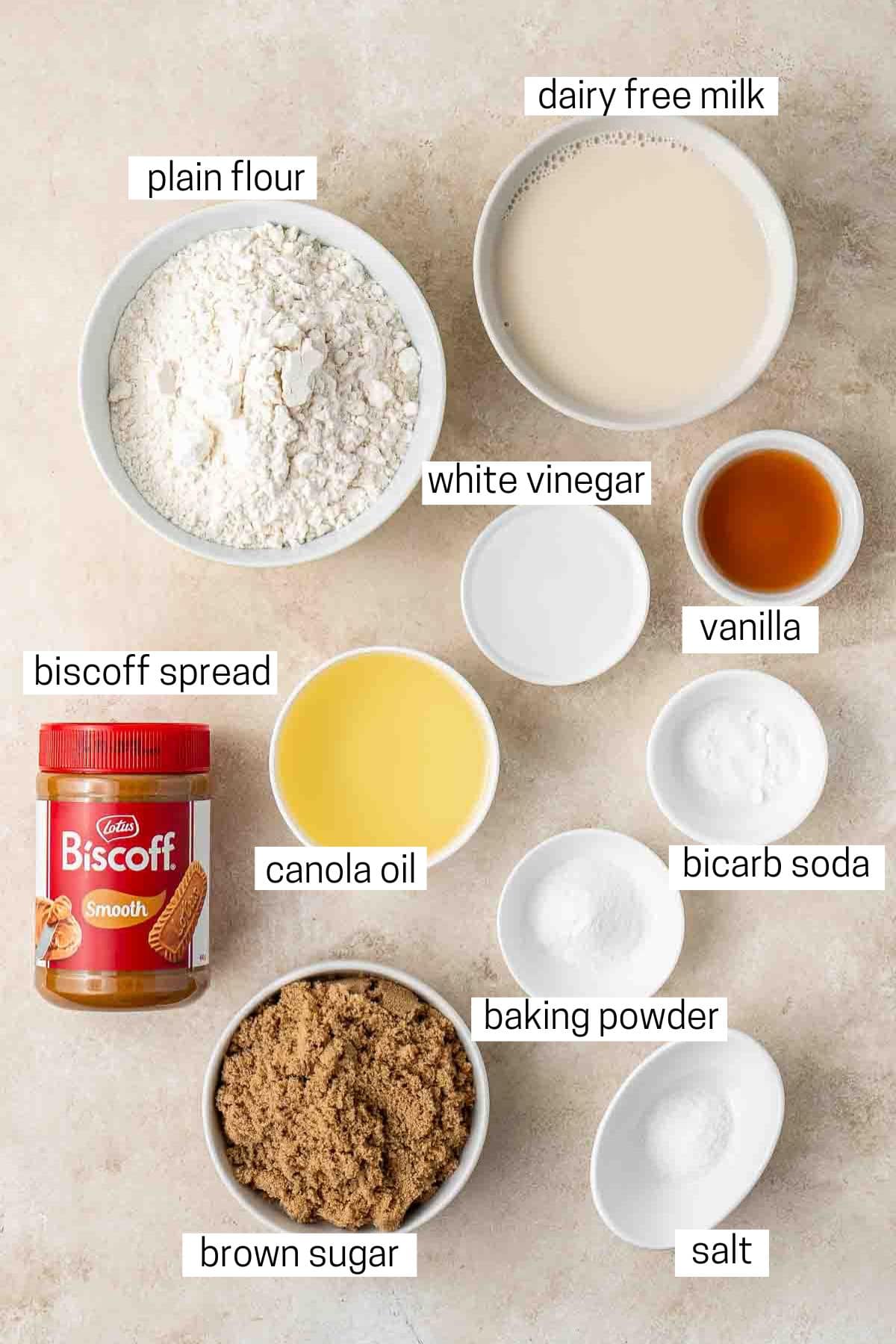
Note all ingredients and their quantities are laid out in the recipe card at the bottom of this post.
- Dairy free milk – I usually bake with either oat milk or almond milk however any plant-based milk you prefer such as soy milk will work well.
- White vinegar – added to the dairy free milk to create a vegan buttermilk alternative that helps achieve a soft texture. You can use apple cider vinegar as a substitute.
- Plain flour – also known as all purpose flour in the US.
- Baking powder – helps the cake rise.
- Bicarbonate of soda – also known as baking soda in the US. This reacts with our vegan buttermilk to help give the cake that soft and tender crumb.
- Canola oil – helping keep the cake soft and moist. Any light tasting vegetable oil can be used.
- Brown sugar – regular light brown sugar is going to add sweetness, enhance the caramel flavour of the cookie butter, and add moisture. Light brown sugar is best here and I don’t recommend a substitute as it will impact the overall taste.
- Vanilla extract – we’re adding a good amount of vanilla extract to really enhance the flavours of this cake.
- Biscoff spread – it wouldn’t be a biscoff cake without biscoff! I like to use smooth in baking but you can really use smooth or crunchy in the cake if you want more texture. Smooth is going to work best for the buttercream and the drip however.
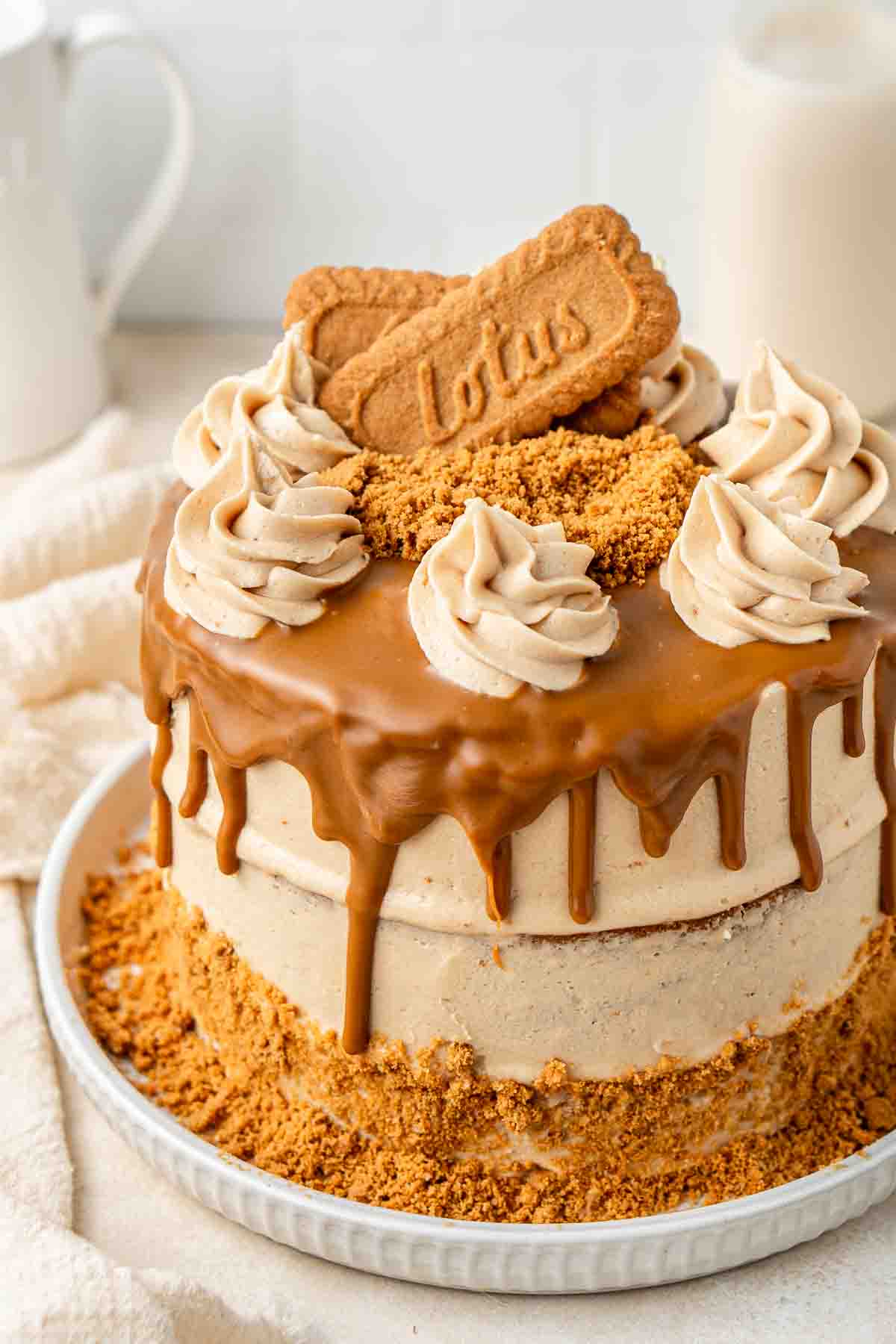
Step-By-Step Instructions
This vegan biscoff cake is very simple to make. All you’ll need is a few bowls, 3 x 6 inch round cake tins and an electric handheld mixer or stand mixer.
Start by mixing together the dairy free milk and white vinegar and setting this aside for about 5 minutes while you prep the rest of the ingredients. This is going to create a vegan buttermilk substitute that will help create a super soft and moist cake texture.
Next, mix together the dry ingredients into a bowl.
Finally, use your electric mixer to beat together the canola oil, brown sugar, vanilla extract and biscoff spread. Add half of the dry ingredients and half of the buttermilk and mix until combined. Add in the remaining dry ingredients and buttermilk and beat until a thick batter is formed.
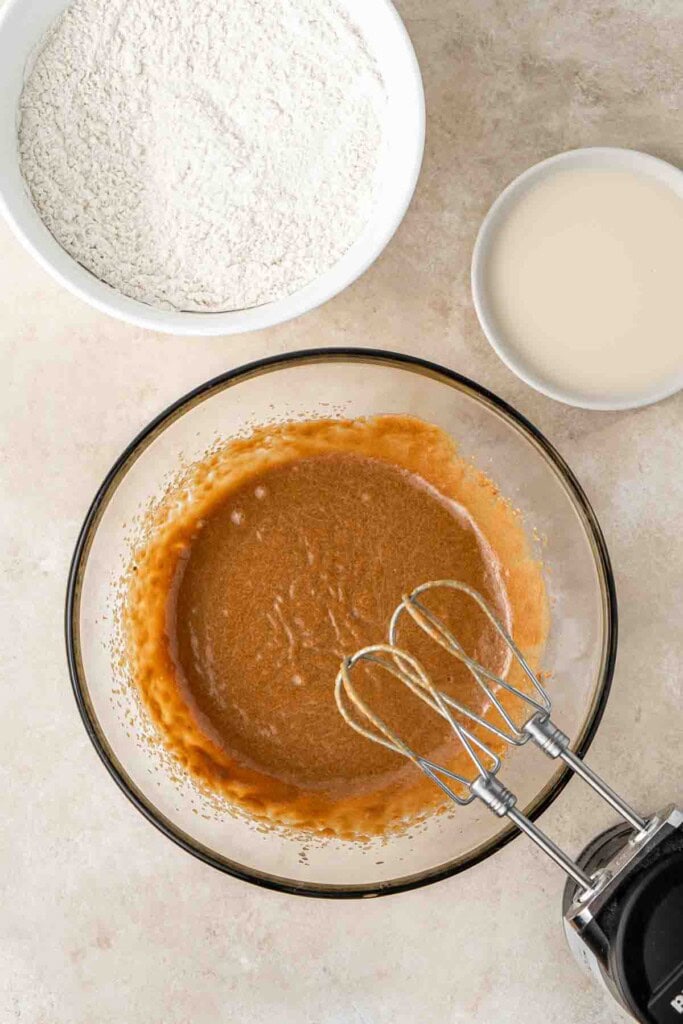
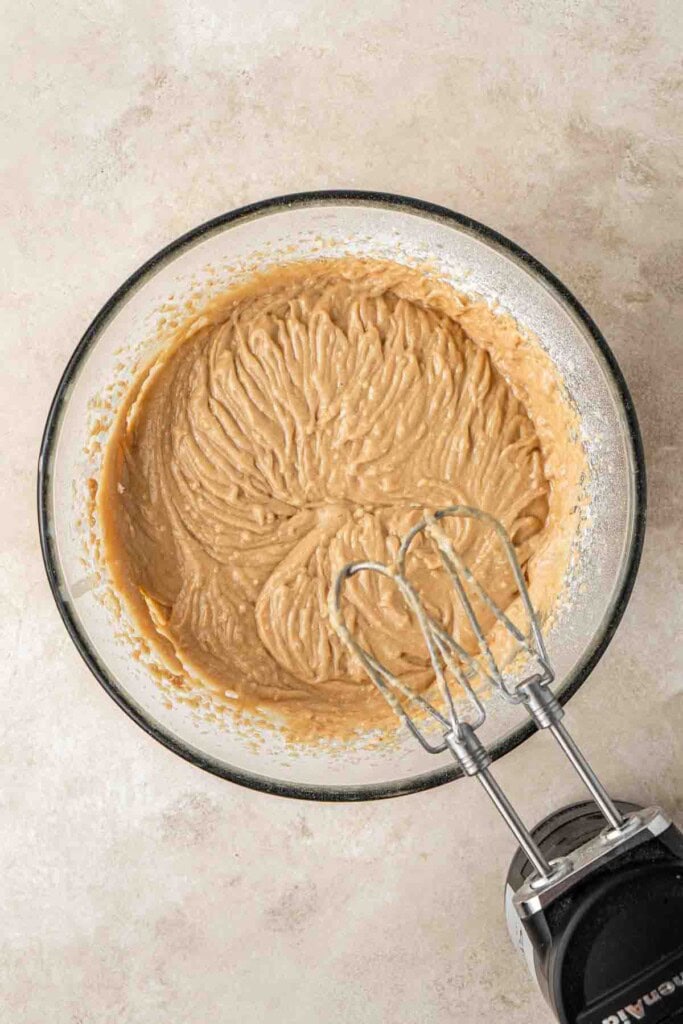
Be careful not to overmix your batter as this can create a gummy and dense texture.
Divide the batter evenly between the three cake pans and then bake in a preheated oven for 30 minutes. Once the cakes spring back when lightly touched, they are ready! Allow to cool in the pan for a few minutes before turning out onto a wire rack to cool completely.

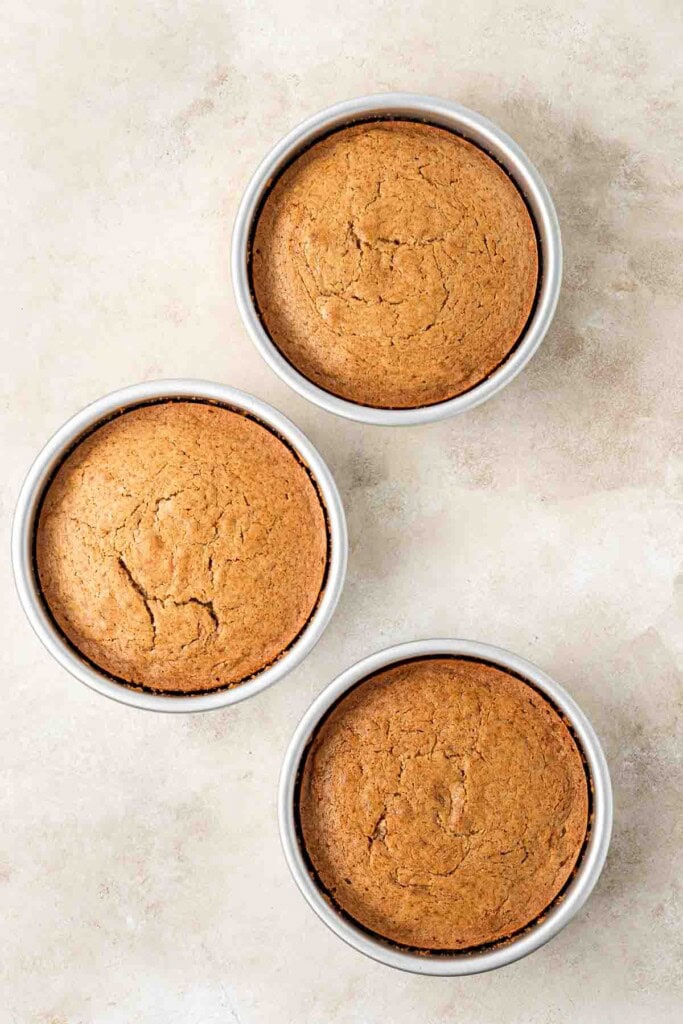
Assembling The Cake
To assemble the cake, start by making a batch of my vegan biscoff buttercream. This recipe (which is also listed below in the recipe card) will make enough to fill the layers and provide a light coating on the tops and sides as well as have a small amount left over for decorating the top as I’ve done.
To ensure smooth sides, I like to start with a crumb coat and then chill the cake in the fridge or freezer before finishing.
To do this, assemble the cake by placing a small amount of the buttercream on a cake stand or plate and place the first cake layer down. If your cake layers have domed, make sure to level them first with a serrated knife.

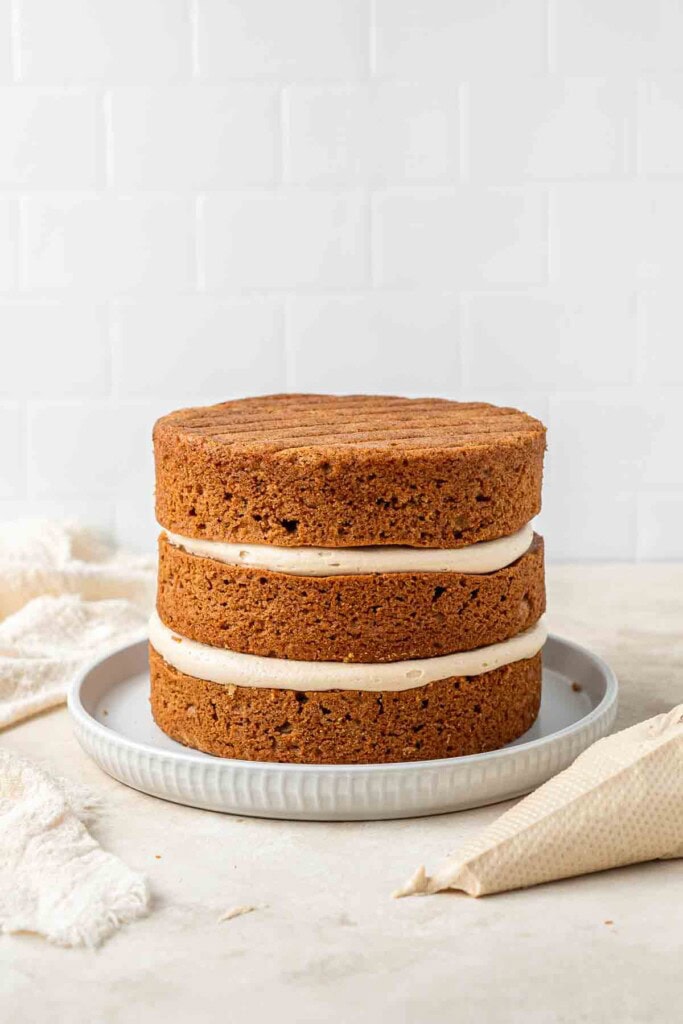
Add enough frosting to thickly cover the layer and then add the second cake layer on top. Add more frosting, then the final cake layer upside down so the top of the cake is flat. Add more frosting to the top and side of the cake using your offset spatula and use a cake scraper or knife to smooth out the edges and remove any excess frosting.
Place the cake in the fridge or freezer to chill for at least 30 minutes.
Once the cake is cold, you can add another layer of buttercream to the tops and sides and use a cake scraper or knife to smooth out the edges if you’re wanting the outside to be completely frosted and smooth. Don’t worry if you can’t get it 100% smooth, it takes practice and patience, and if I worried about it being perfect I’d never finish a cake!
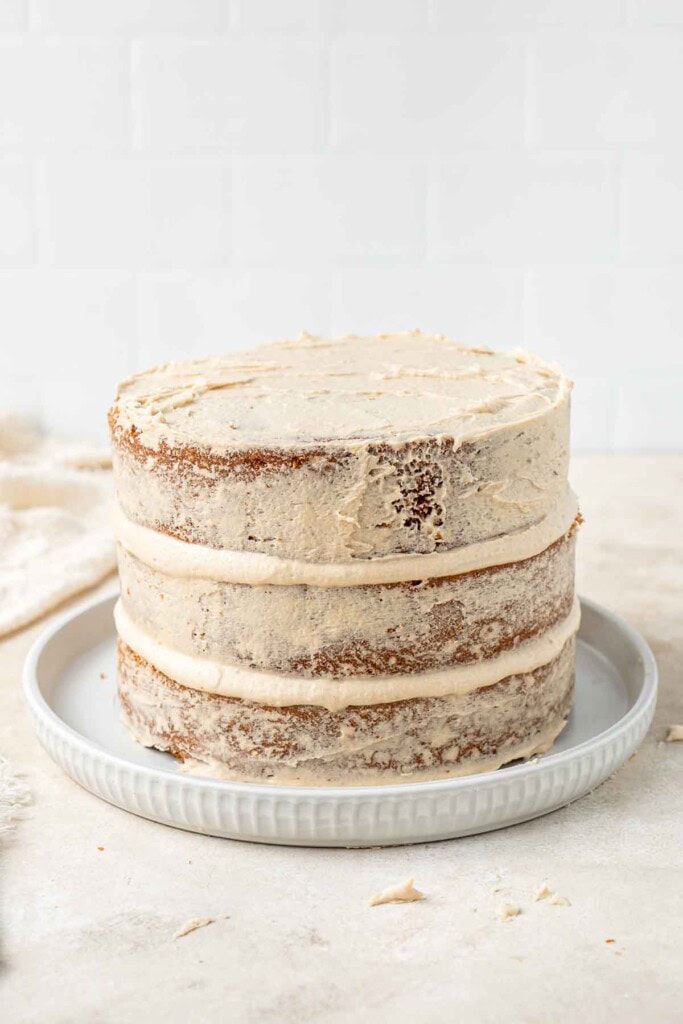
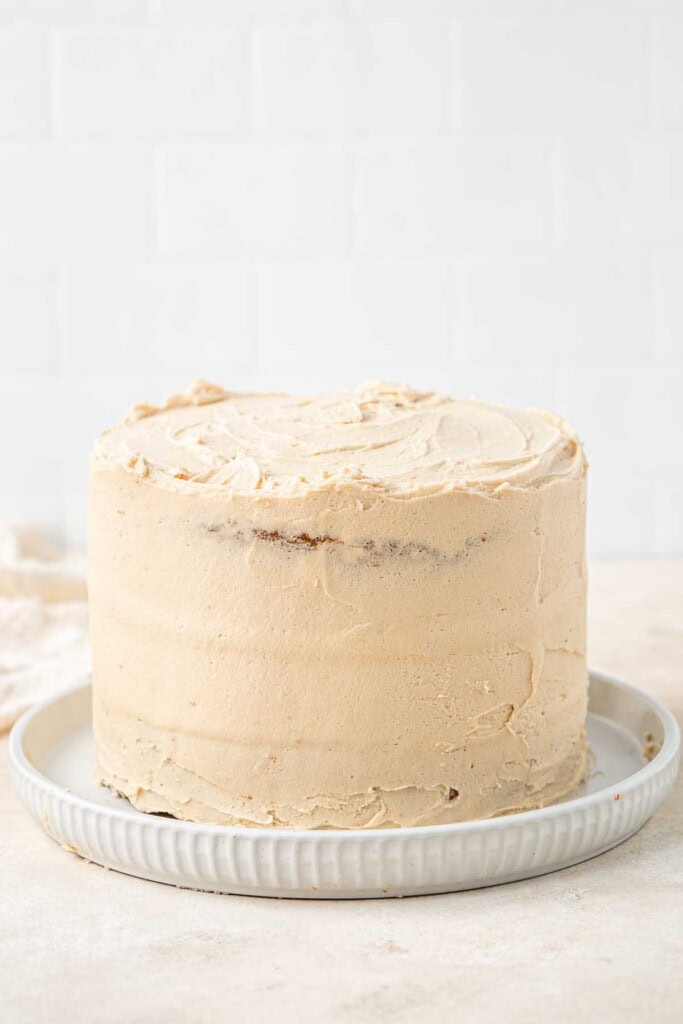
Now it’s onto decorating which is the fun part! This also is going to help hide any imperfections in the finish.
Crush up some biscoff cookies using a mortar and pestle or a zip lock bag and a rolling pin and then use your hands to gently press the cookie crumbs around the base of the cake.
Melt about ¼ cup of biscoff spread in the microwave for 30 seconds until it’s a drizzly consistency. Use a teaspoon to gently spoon the biscoff onto the top edge of the cake so it flows over the edge and drips down. Again, having a cold cake is going to help here as it will firm up the drip as it moves down the cake, similar to a chocolate ganache drip. So pop the cake in the fridge or freezer again before this step if it’s a bit warm.
Once you’ve worked your way around the cake, spread any leftover biscoff over the top and then finish with some buttercream swirls and extra cookie crumbs in the centre.
Chill the cake to allow it to set before slicing and serving.
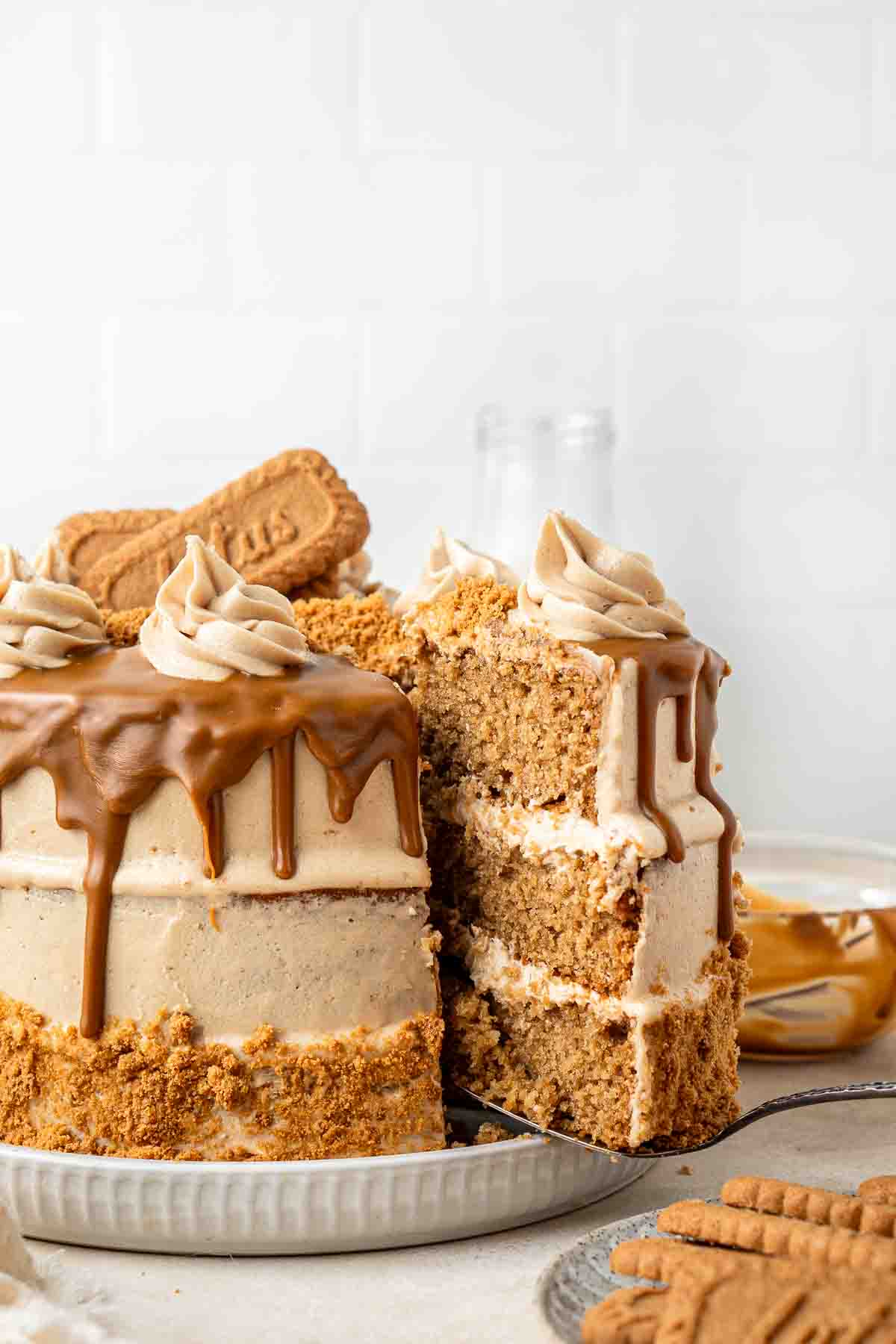
Layer Cake Tips!
- Before assembling the cake, make sure there is no heat at all left in the cake layers. Any residual heat will melt the buttercream and make assembling difficult and messy.
- Make sure to work with a cold cake when decorating, as it will be a lot easier. Also chill the cake before serving as this will allow for much cleaner slices.
- Use a knife to gently level the cakes if they have domed in the oven as this will allow you to have nice flat, even surfaces and help ensure your cake doesn’t start to lean.
- If you want to get better at smoother frosting, investing in a few specialty cake tools will help. I recommend a cake scraper, offset spatula, and cake turntable.
- To break up the steps, you can make the cakes and do the crumb coat the day before serving, and then just finish decorating the day of serving.
Recipe FAQs
It is a Belgian biscuit also known as speculoos that is crispy and crunchy with a rich, brown sugar caramel and cinnamon flavour. Biscoff spread is a creamy spread not unlike Nutella or peanut butter that has been made from these biscuits and often called cookie butter.
The most commonly found brand is Lotus Biscoff and you can find not only the biscuits themselves in Australian supermarkets, but also both the smooth and crunchy cookie butter spreads (find them next to the peanut butter). You can also buy biscoff spread on Amazon.
Biscoff is also completely dairy free and vegan!
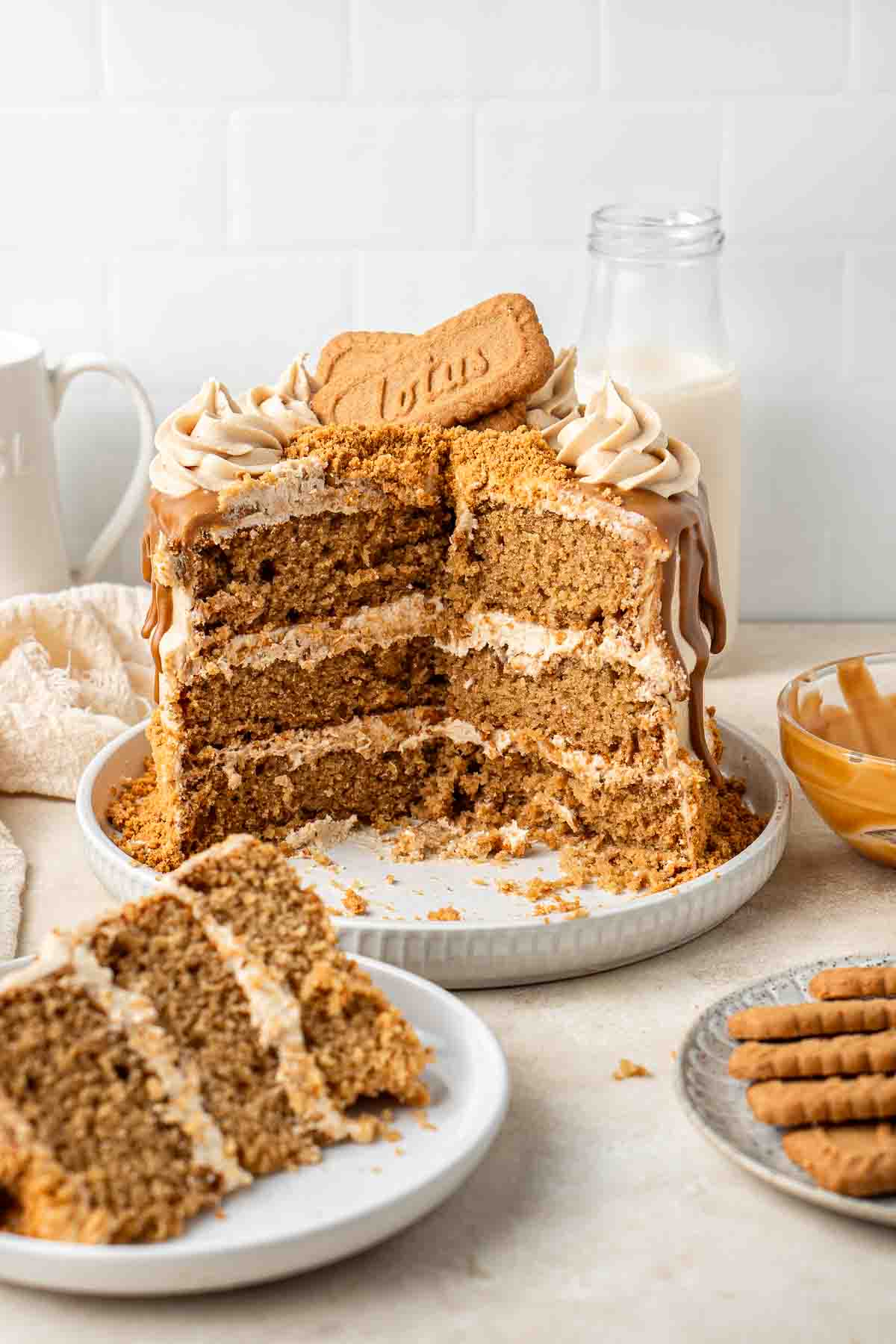
More vegan layer cake recipes:
Vegan Caramel Cake
Vegan Daisy Cake
Vegan Carrot Cake
Vegan Coconut Cake
Vegan Vanilla Cake
Vegan Red Velvet Cake
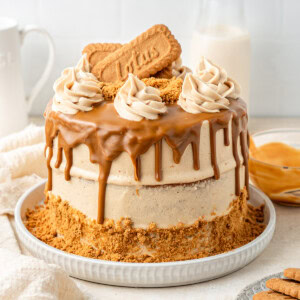
Vegan Biscoff Cake
Equipment
Ingredients
For the vegan biscoff cake:
- 1 cup dairy free milk
- 1 ½ tablespoons white vinegar
- 2 cups plain flour
- 1 teaspoon baking powder
- ½ teaspoon bicarbonate of soda
- ½ teaspoon salt
- ½ cup canola oil
- ¾ cup brown sugar
- 1 tablespoon vanilla extract
- 150 grams biscoff spread smooth
For the vegan biscoff buttercream:
- 125 grams vegan butter
- 100 grams biscoff spread smooth
- 2 teaspoons vanilla extract
- 3-4 cups icing sugar
- 3-4 tablespoons dairy free milk
- ¼ teaspoon salt
To decorate:
- Lotus biscoff biscuits
- ¼ cup biscoff spread smooth
Instructions
- Preheat the oven to 180°C (350°F) and line the base of 3 x 6 inch (15.2 cm) cake pans with baking paper and a light spray of cooking oil on the bottom and sides of the pans.
- In a small bowl combine white vinegar and dairy-free milk. Set aside.
- In a large bowl, whisk together the plain flour, baking powder, bicarbonate of soda and salt to combine.
- In a separate bowl, beat together the canola oil, brown sugar, vanilla extract and biscoff spread until well combined using a handheld eclectic mixer.
- Add half of the dry ingredients into the wet and half of the milk mixture and mix until combined. Add in the remainder of the dry ingredients along with the milk and again beat until the cake batter just comes together being careful not to overmix.
- Divide the batter evenly between the 3 pans and place in a preheated oven to bake for 30 minutes, or until the cake just springs back when lightly pressed. Take the cakes out of the oven and let cool in the pan for 10 minutes before turning out onto a wire rack to cool completely.
- Make the buttercream. Using a hand mixer or a stand mixer with the whisk attachment fitted, beat the vegan butter, biscoff spread, and vanilla for 1-2 minutes until creamy and combined.
- Add in 2 cups of icing sugar and beat on medium until combined. Add in an additional cup of icing sugar and continue to mix. As mixture thickens, add in the dairy free milk a little at a time until you reach a thick, creamy consistency. If the frosting is too thin or tastes too ‘buttery’, add in an extra ½-1 cup of icing sugar, and if it’s too thick, add a little bit more dairy free milk. Finally add salt to taste and continue to mix until super creamy.
- Assemble the cake. Place a small amount of the buttercream on a cake stand or plate and place the first cake layer down. If your cake layers have domed, make sure to level them first with a serrated knife.
- Add enough frosting to thickly cover the layer and then add the second cake layer on top. Add more frosting, then the final cake layer upside down so the top of the cake is flat. Add more frosting to the top and side of the cake using your offset spatula and use a cake scraper or knife to smooth out the edges and remove any excess frosting. Place the cake in the fridge or freezer to chill for at least 30 minutes.
- Once the cake is cold, add another layer of buttercream to the tops and sides and use a cake scraper or knife to smooth out the edges.
- Decorate the cake. Crush up some biscoff biscuits using a mortar and pestle or a zip lock bag and a rolling pin and then use your hands to gently press the cookie crumbs around the base of the cake.
- Melt extra biscoff spread in a small bowl in the microwave for 30 seconds until it’s a thin consistency. Use a teaspoon to gently spoon the biscoff onto the top edge of the cake so it flows over the edge and drips down. Once you’ve worked your way around the cake, spread any leftover biscoff over the top and then finish with some buttercream swirls and extra cookie crumbs in the centre.
- Chill the cake to allow it to set before slicing and serving.
Nutrition
Nutritional information is provided as a guide only and is calculated using automated online tools, therefore we cannot guarantee the accuracy. We encourage you to make your own calculations based on the actual ingredients used in your recipe.

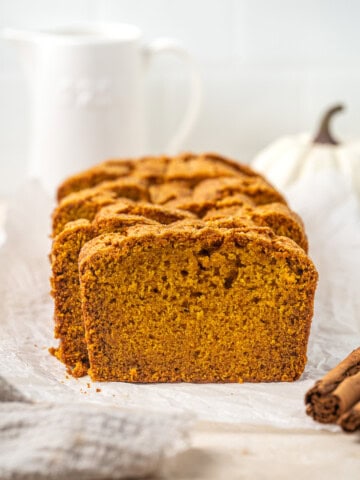
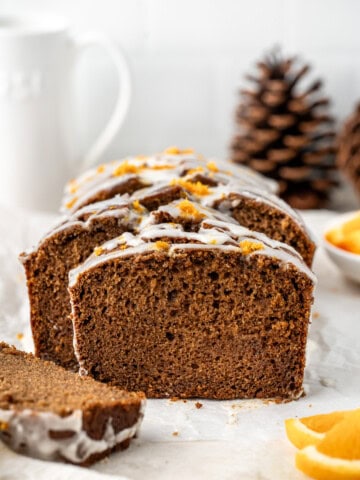
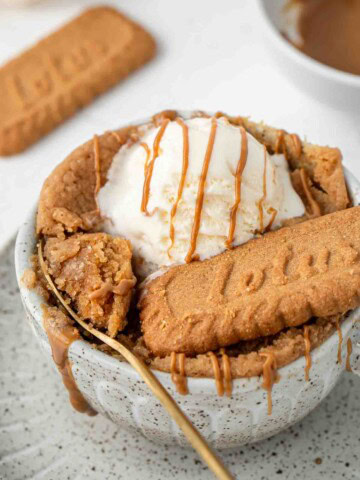
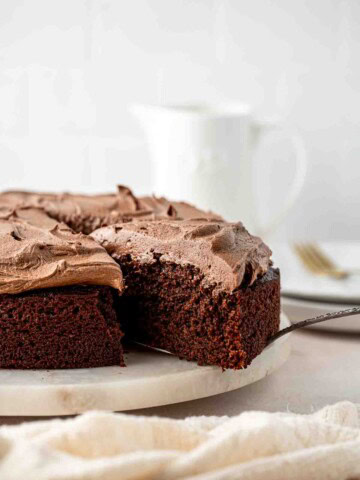
Made this recipe? Leave a review!